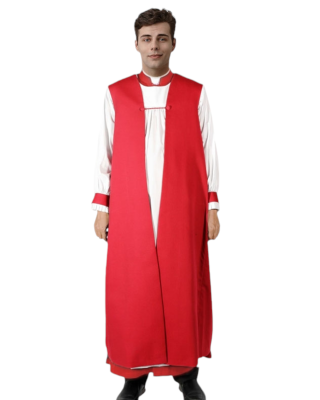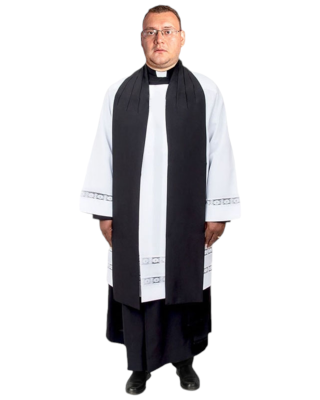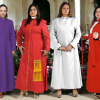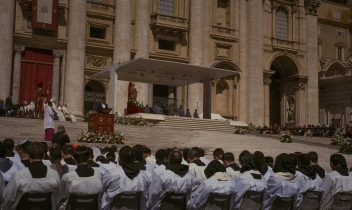
The Complete Guide to Class A Vestments
What are Class A vestments in the clergy? Class A vestments in the clergy are formal, traditional garments worn by clergy members during significant religious services and ceremonies. These vestments often symbolize respect for the sacredness of the occasion and reflect the office or rank of the clergy member.
Typically, Class A vestments include items like cassocks, surplices, stoles, and chimeres. The cassock is a long, robe-like garment worn underneath other pieces, while the surplice is a shorter, white linen or cotton tunic worn over the cassock. The stole, usually draped over the shoulders, is a symbol of ordination and often matches the liturgical color of the season. The chimere, a sleeveless outer garment, is often worn by bishops or other high-ranking clergy over the cassock and surplice.
In religious leadership, attire is more than just clothing; it is a statement of faith, tradition, and reverence. Among the various garments worn by clergy, Class A vestments hold a particularly special place. These formal vestments, often consisting of clergy robes and the distinguished clergy chimere, are traditionally worn for significant liturgical services and ceremonial occasions. Understanding the history, purpose, and evolving trends of these garments can provide valuable insight into their role in religious life.
Here you will explore the rich tradition behind Class A vestments, the intricate details of clergy robes and chimeres, and the growing influence of modern trends on these sacred garments. Whether you’re a member of the clergy looking to invest in quality vestments or someone with an interest in religious attire, this guide will offer both historical context and practical tips.
The Tradition of Class A Vestments
Class A vestments have a long and storied history that dates back centuries. Worn by bishops, priests, deacons, and other religious leaders, these garments symbolize the sacred office of the clergy and their role as spiritual guides. Class A vestments are most commonly worn during high services, ordinations, consecrations, and other ceremonial occasions where formality and tradition are paramount.
The term “Class A” generally refers to the highest standard of formal clergy vestments, often reserved for special liturgical events. These vestments typically include several key pieces, such as the clergy robe, chimere, cassock, tippet, and sometimes a stole or cross.
Clergy Robes: The Foundation of Class A Vestments
The clergy robe is the most recognizable element of Class A vestments. A long, flowing garment worn over the cassock, it serves as a reminder of their spiritual responsibilities. Traditionally, clergy robes are black, signifying humility and the servant-leadership role of the clergy. However, in some denominations and during special services, robes may be white, red, or another liturgical color.
Clergy robes are designed to convey dignity and respect. They are often made from high-quality materials such as wool, polyester blends, or even silk, depending on the level of formality. Many robes also feature pleats, cuffs, and piping details that add to the garment’s stately appearance.
One of the most important aspects of clergy robes is their fit. While tradition dictates that robes should be modest and free-flowing, comfort and practicality are also essential considerations. Modern clergy robes often incorporate features such as concealed zippers, breathable fabrics, and adjustable cuffs to accommodate the needs of today’s religious leaders.
Clergy Chimere: A Unique and Distinctive Garment
The clergy chimere is a unique and distinctive piece of attire worn as part of Class A vestments. Traditionally associated with bishops and higher-ranking clergy, the chimere is a sleeveless outer garment, often worn over a cassock and clergy robe. It typically features an open front and is made of lightweight, flowing fabric such as satin, silk, or fine wool.
The chimere is most commonly seen in Anglican, Episcopal, and some Methodist traditions, where it is worn during important liturgical events like ordinations and consecrations. Its origins date back to medieval England, where it was adapted from the academic gowns worn by scholars. Over time, the chimere became an integral part of ecclesiastical attire, representing both scholarly authority and spiritual leadership.
One of the key characteristics of the clergy chimere is its color. Traditionally, the chimere is red, purple, or black, depending on the rank and office of the clergy member wearing it. For example, bishops may wear a red chimere during ceremonial services, while other clergy members may opt for black. These color choices are deeply rooted in the symbolism of the church and often reflect the liturgical season or the specific role of the clergy member.
While the chimere is a traditional garment, modern designs offer variations in fabric and cut to suit different climates and personal preferences. Today’s clergy members can choose chimeres made from lighter materials that provide greater comfort during long services or in warmer weather.
Modern Trends in Class A Vestments
As with many aspects of religious life, the world of clergy vestments is not immune to modern trends and influences. While tradition remains a cornerstone of Class A vestments, there has been a noticeable shift towards more contemporary designs, fabrics, and customization options. These changes reflect the evolving needs and preferences of today’s clergy.
Sustainable and Eco-Friendly Fabrics
One of the most significant trends in clergy attire is the move towards sustainable and eco-friendly fabrics. As environmental awareness grows, many clergy members are seeking vestments made from organic cotton, bamboo, or recycled materials. These fabrics not only reduce the environmental impact of production but also offer superior comfort and breathability during services.
In addition to sustainable materials, many clergy are choosing vestments produced through ethical manufacturing practices. Fair-trade certifications, minimal waste production, and eco-conscious dyeing processes are becoming increasingly important to clergy members who want their attire to align with their personal values.
Customization and Tailoring
Customization is another trend that has gained traction in recent years. Today’s clergy members are no longer limited to one-size-fits-all garments. Instead, they have the option to invest in tailored vestments that are designed to their exact measurements. Custom-fit clergy robes and chimeres provide not only a more polished appearance but also greater comfort and ease of movement.
Customization also allows clergy members to add personal touches to their vestments, such as embroidered symbols, initials, or custom color combinations. This trend enables clergy members to express their individuality while still adhering to the traditional standards of their denomination.
Gender-Inclusive Designs
As the role of women in religious leadership continues to grow, the demand for gender-inclusive vestments has also increased. Historically, clergy robes and chimeres were designed primarily for men, but today, there are more options available for women and non-binary clergy members. These garments are tailored to fit a wider range of body types and provide the same level of dignity and respect as traditional vestments.
Gender-inclusive designs ensure that all clergy members, regardless of gender, can find vestments that fit comfortably and reflect their role within the church.
How to Choose the Right Class A Vestments
When selecting Class A vestments, it’s important to consider several factors, including the type of services you’ll be leading, the liturgical season, and your personal preferences. Here are some practical tips for choosing the right vestments:
- Consider the Occasion: Class A vestments are typically reserved for formal occasions, such as ordinations, consecrations, and high liturgical services. Make sure the vestments you choose are appropriate for the specific event.
- Select the Right Fabric: The fabric of your vestments can significantly impact your comfort during services. Consider lightweight, breathable fabrics for warmer climates and heavier materials for colder seasons.
- Focus on Fit: Ill-fitting vestments can be uncomfortable and distracting during services. Consider investing in custom-fit garments that are tailored to your specific measurements.
- Pay Attention to Color: The color of your vestments should reflect the liturgical season and your role within the church. Red, black, and purple are common colors for Class A vestments, but some occasions may call for white or other liturgical colors.
- Invest in Quality: High-quality vestments may come with a higher price tag, but they are worth the investment. Quality garments will last longer, maintain their appearance, and provide a sense of dignity and respect during religious services.
Conclusion
Class A vestments hold a significant place in the tradition and ceremony of religious leadership. Whether worn for high services, ordinations, or consecrations, these garments reflect the dignity, authority, and spiritual responsibilities of the clergy. From the clergy robes to the clergy chimere, each piece of attire carries deep symbolism and meaning that connects clergy members to the long history of the church.
As modern trends such as sustainable fabrics, customization, and gender inclusivity continue to shape clergy vestments, today’s religious leaders have more options than ever to find garments that reflect their values, personal style, and role within the church.
For those looking for high-quality Class A vestments, Clergy Wear Shop offers a wide selection of clergy robes, chimeres, and accessories. With a focus on tradition, craftsmanship, and comfort, Clergy Wear Shop provides custom-fit garments that meet the needs of modern clergy while preserving the sacred heritage of religious attire.
Frequently Asked Questions (FAQs)
What are Class A vestments?
Class A vestments are formal clergy garments worn during significant liturgical events such as ordinations, consecrations, and high services. They typically include clergy robes, chimeres, cassocks, and other ceremonial attire.
What is the difference between a clergy robe and a clergy chimere?
A clergy robe is a long, flowing garment worn over the cassock, while a clergy chimere is a sleeveless outer garment worn over the robe. The chimere is often worn by bishops and higher-ranking clergy during ceremonial occasions.
What fabrics are used in Class A vestments?
Class A vestments are traditionally made from high-quality materials such as wool, silk, or polyester blends. Modern vestments may also use sustainable fabrics like organic cotton or bamboo.
Can Class A vestments be customized?
Yes, many clergy members choose to invest in custom-fit vestments that are tailored to their specific measurements. Customization options may include embroidered symbols, unique color combinations, or personalized touches.















Add comment
You must be logged in to post a comment.